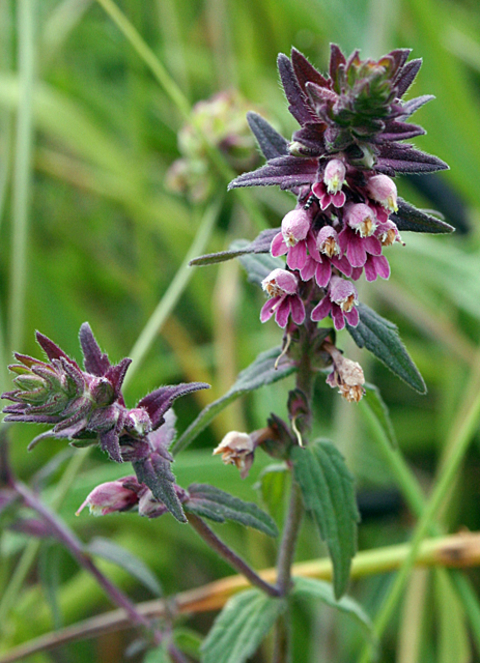Quick facts
- Red bartsia (Odontites vernus) is a non-native plant that has been found in Minnesota.
- Red bartsia is an annual plant that can produce 1,400 seeds per plant.
- Look for it next to roads and trails and in pastures and hayfields.
Please report this species so we can better understand its distribution in the wild. Use the Great Lakes Early Detection Network (GLEDN) free mobile app.
Red bartsia has been spotted in northern Minnesota. It is more common in Manitoba, Canada so could impact northwestern Minnesota first. It has been found roadside and trailside, but can be found in pasture. Coarse hairs on the seeds enable easy and rapid spread. This species can seriously impact pasture and hayfield economics.
How to identify red bartsia
Red bartsia is a short plant, 6 to 12 inches tall, with a straight stem and noticeable reddish-purple flowers in late spring.
- Stems: Erect, 6-12 inches tall, hairy, branches in pairs (opposite).
- Leaves: Narrow, hairy, clasping leaves in pairs about one inch long. Leaves are hairy with small lobes/large serrations on the edges.
- Flowers: Reddish-purple flowers, 8-10 millimeters long. Flowers have two lips, the bottom lip has 3 lobes. Flowers develop at the top in spike-like clusters in late spring until fall.
- Seeds: Small, 1-2 millimeters long, with ridges. Up to 1,400 seeds per plant per year. Seeds may be viable in the soil for more than 9 years.
- Roots: Partially parasitic to some grasses, red clover and plantain.
Common look-alikes
Self-heal (Prunella vulgaris), also known as heal-all, has tubular purple flowers. It is in the mint family, has square stems, flowers are clustered together in a spike, leaves can be 2.75 inches long with smooth edges and no lobes.
Helleborine (Epipactis helleborine), has a tubular flower that varies in color from yellow and green to pink and purple. The plant is 1-3 feet tall. Leaves are 1 ½ - 6 inches long and ½ to 3 inches wide, hairless, toothless and have parallel veins.
Reporting and controlling red bartsia
Please report red bartsia. As with all non-native species found in unmanaged areas, report findings of this species using one of the following methods:
- Use the Great Lakes Early Detection Network (GLEDN) free mobile app (preferred).
- Report using the EDDMapS Midwest web-based mapping system for documenting invasive species.
Management
- Cultivation: Red bartsia generally doesn’t persist in crops that are cultivated annually.
- Mechanical control: Small populations can be hand pulled. Mowing is not recommended as it is likely to spread seeds.
- Herbicide control: Spot spray plants with 2,4-D. Treatments to seedlings and plants that have not yet turned purple are likely to be more effective than treating plants in late summer. Since it is an annual plant, the goal is to prevent the plant from developing seeds.
Reviewed in 2021


